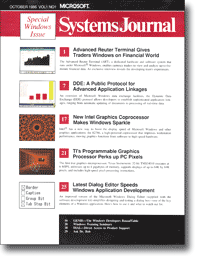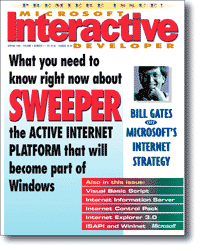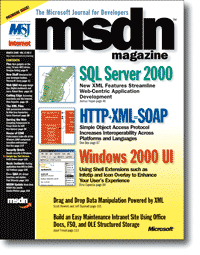Editor's Note
20 Years and Still Going Strong!
Microsoft Systems Journal (MSJ) was founded in 1986. At the time, no other publication focused specifically on the needs of programmers who were using Microsoft tools and technologies. Two issues were produced in the first year, each with five articles. From this experiment 20 years ago, we have grown to the magazine you have in front of you today.
Along the way, we have reported on some of the most important technologies of an ever-changing, always fascinating industry. If you are looking for a history of programming for the past two decades, you'll find it in the pages of MSJ, Microsoft Internet Developer (MIND), and finally MSDN Magazine. In this, our 20th year of publication, we thought we'd step back and look at some of the key topics we've brought you over the years.
1986 A year after the launch of Windows 1.0, MSJ launches its first issue. Key topics include Windows 1.0, MS-DOS, and Microsoft XENIX. Typical articles include "Aldus: Preparing PageMaker for the Move to Windows" and "DDE: A Public Protocol for Advanced Application Linkages."

"Working on MSJ and later MSDN Magazine was, like the magazine itself, always stimulating, decidedly cutting edge, and an amazing opportunity to learn from the best in the industry."—Joanne Steinhart, Editor-in-Chief
1987 In March, MSJ becomes a bimonthly publication. You would've learned about Windows 2.0, Windows 386, and OS/2, as well as brand new CD-ROM technology. Articles like "Microsoft OS/2: A Foundation for the Next Generation" and "Microsoft Excel for Windows: Meeting the Demands of a New Generation" really showed our love for the word "generation."
1988 Branching out a bit from pure systems coverage, MSJ discusses SQL Windows, QuickBasic 4.0, and other languages. May brings the first discussions of DLLs in the article "Design Concepts and Considerations in Building an OS/2 Dynamic-Link Library." The C language is pretty much your only choice for serious systems-level programming without assembler.
1989 MSJ still has a systems-level focus, with articles about emulating UNIX serial I/O interfaces and using 80286 protected mode functions. Charles Petzold writes his famous series "Programming for Presentation Manager," including a program called Checkers. Disappointingly, it makes no references to Richard Nixon's dog.
1990 A watershed year for users, developers, and MSJ. In July MSJ runs its first introduction to Windows 3.0. This is generally considered the release in which Windows really takes hold with consumers and, not coincidentally, with developers.
"When I was designing the prototype of MSJ in August of 1986, Jon Lazarus told me that my main mission was to create something new for developers—a magazine that would present code as clearly and prominently as the article text, which was a radical notion at the time." —Michael Longacre, Editor-in-Chief
1991 Microsoft begins joint publication of MSJ with M&T Publishing. 15 years later, its descendant, CMP Media, still publishes MSDN Magazine in partnership with our editorial staff here at Microsoft. 1991 is a banner year for development. In May, MSJ runs its first C++ coverage. In July, MSJ provides the first look at a new language, Visual Basic, which revolutionizes the way people write accounts payable systems with bright red window backgrounds. In September, Windows 3.1 is discussed, along with innovations like OLE and TrueType. September also marks the last discussion of the ill-fated OS/2. November provides the first discussion of the Windows 32-bit API, later known simply as Win32.
1992 As Microsoft prepares to release its first version of C++, MSJ looks at MFC for the first time in March. This is followed by the first coverage of Windows NT in July, and the biggest event of all in September—MSJ becomes a monthly publication.
1993 C++ is quickly becoming the standard language for Windows-targeted programming, and in February, Paul DiLascia writes his first C/C++ column. Paul is still writing a monthly column for MSDN Magazine today.
1994 Windows 95, code-named "Chicago," is debuted in the January issue. The Internet is quickly becoming the hot new pastime for consumers, leading to our September coverage "Getting Wired Into the Internet: A Crash Course on FTP, Gopher, Web, and More."
1995 In May, Jeff Prosise files the last installment of his MS-DOS Q&A column. He writes a series on programming for Windows 95, followed by the debut of his Wicked Code column. In June, Don Box writes his first OLE Q&A column. Windows 95 is released, providing millions of users with a built-in TCP/IP stack and simplified Internet access. It is followed closely by the release of Visual Basic 4.0, which bridges the gap between the 16-bit world of Windows 3.x and the 32-bit world of Windows 95.

"Al Gore may have helped create the information superhighway, but in starting Microsoft Interactive Developer in 1996, we built its first rest stop—complete with facilities."—Eric Maffei, Editor-in-Chief
1996 Microsoft Interactive Developer (MIND) is launched in the spring, featuring an interview with Bill Gates and an overview of "Sweeper," the code name for a package of technologies that becomes WinInet, part of ActiveX. The MSJ Web site launches. In November, Don Box's column reflects the evolution of the times by becoming ActiveX/OLE Q&A. It will later change into ActiveX Q&A before becoming House of COM in July 1998.
1997 MSJ continues to diversify its focus. February brings Visual Basic 5.0, which lets you create ActiveX controls. April's issue provides the first coverage of Windows CE, the version of Windows for mobile devices. June brings the first look at Active Template Library, as well as a sneak peek at Windows NT 5.0, which becomes Windows 2000. Finally, our October issue features John Robbins's first Bugslayer column as well as a look at Active Desktop for Internet Explorer 4.0.
"In my first week of work in 1989, I went to see how OS/2 was being used at KFC and shared a bucket with Steve Ballmer." —Laura Euler, Senior Editor
1998 With new technology comes new fears, and in the wake of the building Y2K Fever, technical editor Joe Flanigen sets off a small wave of terror in July by explaining how dates in MFC only run through the year 2038. MIND changes its name, but not its acronym, to Microsoft Internet Developer. Meanwhile, MSJ continues to become more Internet focused. Articles like "How to Design Reusable HTTP Components by Exploiting WinInet and COM" vie for space alongside assembly language and Win32. In November, Keith Brown writes his first Security Briefs column.
1999 After more than a decade with the publications, editor-in-chief Eric Maffei retires, taking his many references to "2001: A Space Odyssey" with him. C++ is not the only game in town anymore—OLE DB and ADO, along with Visual Basic, are now seen as mainstream programming and receive lots of coverage in MSJ.
2000 As the worlds of traditional desktop, server, and Internet-based programming converge, we reflect this trend by combining MSJ and MIND to form MSDN Magazine. The first issue covers topics from SQL Server 2000 to SOAP. In July, MSDN Magazine scores a coup by publishing a special edition in conjunction with the Microsoft PDC in Orlando, where the .NET Framework is unveiled. We become the first magazine to provide technical coverage of the .NET Framework and C#.
2001 Having overseen the successful launch of MSDN Magazine, editor-in-chief Michael Longacre retires to his gracious country estate. Windows XP is the hot topic, both in the pages of MSDN Magazine and at the Microsoft PDC in Los Angeles. With in-depth monthly coverage, .NET has become the heart of MSDN Magazine.

2002 MSDN Magazine becomes part of the MSDN subscription program in the United States. We are careful to temper our .NET coverage with "guru" stories like "Inside Windows: An In-Depth Look into the Win32 Portable Executable File Format." In a nod to the increasingly important role that security plays in the world of programming, MSDN Magazine launches its first annual security- themed issue in November.
"What strikes me most over the last six years is the dedication of every member of the team involved. We all believe in what we are doing and the goals we have set together."—Kerry Gates, Publisher
2003 Building upon the success of our first "mini-mag" in 2000, MSDN Magazine publishes a special edition for the Microsoft PDC in Los Angeles. The 48-page supplement focuses on the next version of Windows, code-named "Longhorn," and the next version of SQL Server, code-named "Yukon."
2004 After more than 15 years with the group, editor-in-chief Joanne Steinhart retires. The first holiday season without her famous cookies is indeed bleak for many staffers. Building on the success of MSDN Magazine, we launch TechNet Magazine for the IT professional market and we begin to talk about "Whidbey," the code name for both Visual Studio 2005 and the .NET Framework 2.0.
2005 MSDN Magazine is now received by about 150,000 readers a month in 25 countries, with eight local editions. For 20 years, we have maintained one simple goal—we want to be your first source for understanding how to develop with Microsoft tools and technologies. We've been successful by keeping this in mind every month, but we really couldn't do it without your loyal readership over the years. From the bottom of our hearts, we thank you for all you've helped us become, and we're looking forward to the next 20 years.
Thanks to the following Microsoft technical experts for their help with this issue: Pablo Castro, Felix Cheung, John Durant, Erick Ellis, David Fries, Robert Green, Sam Guckenheimer, Kelvin Hoover, Elena Kharitidi, Ronald Laeremans, Gerrard Lindsay, Rico Mariani, Randy Miller, Brian Pepin, Jennifer Perret, Elliot Rapp, Mark Rideout, Stefan Schackow, Joe Stegman, Anson Tsao, Maura Van Der Linden, and Ravinder Vuppula.
ActiveX, DirectX, IntelliSense, JScript, Microsoft, MSDN, SharePoint, Visual Basic, Visual C++, Visual SourceSafe, Visual Studio, Windows, Windows NT, Win32, and Windows Server are either registered trademarks or trademarks of Microsoft Corporation. Other trademarks or tradenames mentioned herein are the property of their respective owners.
MSDN Magazine does not make any representation or warranty, express or implied with respect to any code or other information herein. MSDN Magazine disclaims any liability whatsoever for any use of such code or other information.